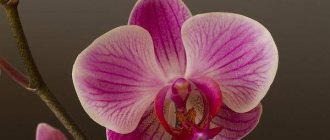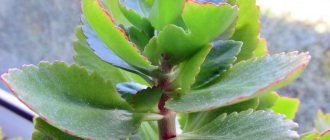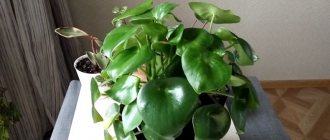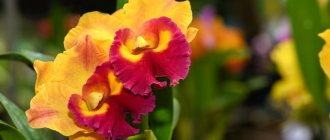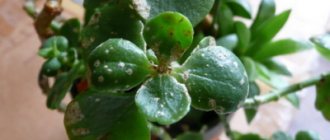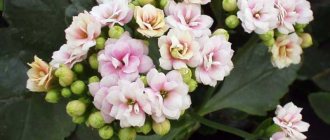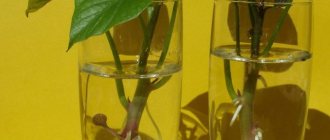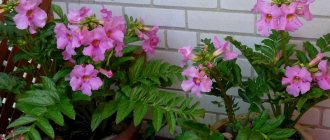Description of the genus Kalanchoe
Kalanchoe, part of the family Crassulaceae (Crassulaceae), is a fairly large genus, which includes 1 species from the Americas, 56 species from southern and eastern Africa, 60 species from Madagascar and several species from Asia. In total, the genus Kalanchoe has about 125 species. The island of Madagascar has the largest number of species of this genus, suggesting that it is the ancient center of speciation and possibly the place of origin of Kalanchoe. After all, Madagascar is the only region where epiphytic, woody, liana-like and herbaceous varieties of Kalanchoe live.
Photo of Kalanchoe rhombopylosa
Previously, the genus Kalanchoe included not only its natural varieties, but also representatives from other genera. Because of this, even now there is often confusion with the total number of species of the genus. This confusing situation is due to the fact that taxonomic classification has not yet been carried out for Kalanchoe.
At the time of discovery, many plants were given very different names: in the 18th century they were known as Cotyledon, from 1805 they were included in the genus Bryophyllum (Bryophyllum), and only 80 years later they were reclassified as the genus Kalanchoe. The current quantitative composition of the genus was determined only in the middle of the 20th century. And the closely related Bryophyllum was separated into a separate genus and is currently considered as one of three sections of the genus Kalanchoe.
Description of the appearance of Kalanchoe
Most members of the genus tend to be perennial succulent crops in their natural habitat. Some species are annual or biennial plants. Outwardly, they may look like ordinary succulents, some like shrubs or even trees. Several species are classified as epiphytes, that is, they grow on the surface of other plants; there are also climbing plants. Naked or hairy succulent plants can reach heights ranging from a few centimeters to 3-4 meters.
Photo of Kalanchoe laxiflora
The fleshy, sometimes woody stems of succulents often have multiple branches, depending on the species. The fleshy leaves are varied in shape, usually arranged oppositely, sometimes in whorls of three, rarely alternate. The leaves are entire or serrated, lobed, pinnately incised or pinnately divided. In some species, plant buds are located right at the edges of the leaves, from which new plants develop.
Photos of flowers of different types of Kalanchoe
Monoecious flowers open on erect stems. Each of them consists of four, more or less fused sepals and petals, which grow together into a tube and have bright colors. The tips of the petals are curved back.
Kalanchoes are short-day plants and they bloom when the day length is equal to or less than 12 hours. If pollination occurs, after flowering four erect follicle fruits containing many small seeds are formed.
Probably the most famous species of this genus is Kalanhoe blossfeldiana and its cultivars, thanks to its flowers. But some Kalanchoe species are prized for their colorful foliage rather than their flowers. For example, Kalanchoe tirsiflora is prized for its large leaves and rough texture.
We would like to remind you that most species of Kalanchoe have poisonous sap and are toxic. They should be kept away from pets and children.
Species of the genus Kalanchoe with showy flowers
Almost all Kalanchoe bloom beautiful flowers of different shapes, sizes and colors. But several species of this succulent are highly prized by many gardeners because of their amazing flowers.
Kalanchoe blossfeldiana
This species is named after the German breeder Robert Blossfeld (1882-1945). One of the most common houseplants is a dark green succulent perennial shrub with fleshy leaves and large clusters of flowers located above the foliage.
It has erect, branched stems. The flowering time of Kalanchoe Blossfeld is incredibly long for a houseplant - from the second half of autumn to the beginning of spring.
There are varieties with bright red, pink or yellow flower colors. The most famous series of Blossfeld varieties is the double Kalanchoe Kalandiva . This varietal series was originally bred in the Netherlands.
A special feature of Kalandiva is its unique double flowers, visually similar to the buds of garden roses. Other varieties worth mentioning:
- Kalanchoe 'Tom Thumb' is a miniature shrub form, no more than 15 cm high, with reddish foliage and small dark red flowers;
- Kalanchoe Blossfeldiana 'Vulcan' is a long-flowering succulent with large scarlet flowers, growing up to 20cm, flowering 20 weeks after sowing;
- Kalanchoe Blossfeldiana 'Compacta Lilliput' is another diminutive form of the plant with red flowers, growing no more than 15 cm;
- Kalanchoe Blossfeldiana 'Orange Triumph' is a rare variety with orange flowers;
- Kalanchoe Blossfeldiana 'Goldrand' is a less common form of succulent with yellow flowers.
Kalanchoe Fedtschenko
Formerly known as Bryophyllum fedtschenkoi, this species is named after the Russian botanist Boris Fedchenko. This is a low-growing, frost-resistant perennial succulent that grows up to 30 cm in height. The stems are round, smooth, with noticeable scars on the leaves, often bending and touching the ground.
The leaves are fleshy, alternate, blue-green, oval or obovate with fine serrated edges. The leaf tips may turn pink or red in bright sunlight or dry conditions. In late spring - early summer, the plant produces flower stalks with clusters of small bell-shaped flowers. Reddish-brown flowers hang loosely from upright stems.
Houghton's Kalanchoe (Kalanchoe Houghtonii)
The hybrid of Kalanchoe daigremontiana and Kalanchoe delagoensis can be recognized by the V-shaped leaves. It is a biennial, erect, unbranched plant, about 75 cm tall. The leaves are boat-shaped, fleshy, triangular, emerald green to brownish green in color, usually with purple spots below and jagged edges.
Sprouts grow en masse along the edges of the leaves. Spectacular flowers are hanging, bell-shaped, collected in clusters, orange-pink in color. This plant is virtually indestructible and requires no care... none at all. Even if you throw it into a pile of garbage, it will continue to grow and bloom for a long time.
General rules for caring for indoor Kalanchoe flowers
Each species of this genus has its own requirements for light, soil, watering and other criteria. In our articles about these species, we described in more detail the conditions for growing these varieties at home. Here we will describe the general requirements and describe the flowering features in more detail.
What soil composition is optimal for Kalanchoe
Since Kalanchoe is a succulent, the potting medium should be fast-draining. The pH value should be between 6.0 and 6.5. Almost all Kalanchoes are sensitive to zinc deficiency and high phosphorus. Most members of the genus also have high calcium requirements.
- Desert varieties of Kalanchoe require a substrate poor in organic matter, consisting of equal parts of loam and sand, with the addition of pumice or stone chips to ensure good drainage.
- Some species, such as Kalanchoe Blossfeld and its varieties, prefer the presence of a small amount of organic matter in the soil.
Lighting requirements
Mature plants grow best in full sun or partial shade. At home, Kalanchoe should be grown in a well-lit window. But there are nuances. For example, flower formation in Kalanchoe Blossfeld is stimulated by a very short photoperiod. When growing this type of succulent in a pot, it can be stimulated to produce more buds and flowers by giving it 8 to 10 hours of sunlight per day.
Succulent Information
Crassula ovoid or “Money tree”
The most common succulent is Sedum or Sedum.
Succulent Adromiscus: features of the genus
Temperature
All Kalanchoes grow well at normal room temperature. Most of them are native to Africa and can easily tolerate heat. Plants bloom at temperatures from 15 to 16 °C. Avoid temperatures below 5°C as the plant may die within a few hours.
Watering
In autumn and spring, moderate watering is sufficient, but in hot summers, water more frequently and generously and allow to dry out before watering again. In winter, it is worth moistening the soil occasionally (when the plant begins to wither). If during this period you do not reduce the frequency of watering, then the Kalanchoe will grow as usual and will not have a dormant period.
Overwatering is the most common cause of death of succulents. Also avoid using cold water when watering plants, as this can lead to various diseases.
Fertilizer application
Fertilizing requires some attention. You can add liquid fertilizer for flowering succulents diluted in water at half the strength every two to three weeks. Most other Kalanchoe species should be fertilized no more than once a month. They do not require any fertilizer in winter.
Replanting Kalanchoe
Unlike ordinary houseplants that prefer to live in a pot, Kalanchoe grows best if replanted fairly often. For best results, replant desert Kalanchoes annually in the spring and flower varieties in the fall after the plant has finished blooming—this will encourage new growth and increase future blooms. Increase the container by one size each time you replant.
Kalanchoe beharensis
Be sure to use a pot with good drainage. A container made of clay or ceramic is the best choice, as these materials are porous and will help keep the soil relatively dry.
Varieties of Kalanchoe with pubescent leaves
This conditional group of succulents is united by one feature - their leaves are covered with hairs or fluff, which in turn adds to their decorativeness.
Kalanchoe tomentosa
Easy to grow and quite hardy, this is an upright evergreen succulent with soft, fluffy, fleshy leaves, 9 cm long, reminiscent of cat ears.
This native of Madagascar does not bloom as often as other succulents in the home and is grown primarily for its unusual foliage. In summer, clusters of yellow-green flowers with dark brown petal tips may appear on 45cm stems. Kalanchoe tomentosa grows up to 90 cm in height and 60 cm in width.
Also worth mentioning is the beautiful dwarf variety of Kalanchoe tomentosa - “Chocolate Soldier” (Kalanchoe tomentosa cv. Chocolate Soldier) . This is a beautiful, slow-growing perennial succulent plant with dense white felt-like hairs covering the entire leaf.
A small, upright growing bush reaches approximately 40 cm. This is a very attractive variety, which has many varieties with different color options. It is valued primarily for its fluffy leaves.
Kalanchoe dwarf (Kalanchoe pumila)
This is a bushy succulent with hanging and spreading stems. It grows 20 to 30 cm long and 30 to 60 cm wide. It looks amazing hanging from hanging baskets. This flower has curved stems, densely covered with rounded leaves up to 5 cm long.
The leaves are silver-gray with a pinkish tint, have a serrated edge and are covered with whitish hairs that give them a matte appearance. The flowers are bell-shaped, pink-violet in color, with distinct yellow anthers.
Kalanchoe millotii
Another succulent, growing in the arid regions of Madagascar, forms a small bush up to 30 cm high. The leaves are pale green, jagged, covered with a dense felt coating.
Kalanchoe Millota produces numerous flowers that appear in clusters on long stalks. The flowers are tiny, white, and look like Chamomile flowers. The plant is easy to grow and its low maintenance requirements make it an excellent plant for any gardener.
Kalanchoe eriophylla or snow-white (Kalanchoe eriophylla)
An excellent representative of the group of plants with pubescent leaves, but besides this, Kalanchoe snow-white stands out for its wonderful flowers. Native to Madagascar, Kalanchoe Eriophylla is a pretty succulent plant with thin, hairy stems and fleshy leaves covered in a fine layer of whitish hairs that give it a furry appearance.
The main stem reaches a length of about 30 cm, densely covered, like the leaves, with a dense mass of white fluffy hairs. The flowers are small, four-petaled, pale pink or purple, with a yellow center, and stand out against the background of a fluffy succulent.
Kalanchoe beharensis or beansis
Quite a large shrub with showy spear-shaped leaves. In ideal conditions it can grow up to 2 m. The leaves are large - up to 40 cm wide, up to 35 cm long, and resemble elephant ears, which is why it is so often called. Kalanchoe becharensis has a long, thin and gnarled stem.
The serrated leaves are olive green, with downy hairs, located at right angles to each other. The flowers are small, greenish-yellowish, on short stalks. The flowering period is from spring to summer.
There is also a subspecies Kalanchoe beharensis var. subnuda , whose leaves are bare and have no downy coating.
Succulent Information
Amazing succulent Aeonium: features of the genus
Crassula or Crassula: features of the genus Crassula
Features of the Agave succulent genus and how to grow them
How to make Kalanchoe bloom
Probably one of the most common questions asked by beginning gardeners. There are two types of photoperiodic flowering responses that have been observed in most Kalanchoe species: plants that flower after exposure to short days (called short-day plants), and plants that flower after exposure to a specific sequence of long days followed by short days (long- and short-day plants). day). Kalanchoes are short-day plants, and by manipulating the length of day and night, gardeners can achieve flowering plants at any time of the year.
Photo of Kalanchoe scapigera
Research has shown that several species of the genus, including the popular K. blossfeldiana, flower in response to day length, classifying these plants as photoperiodic with respect to flowering.
Long daylight hours stimulate good rooting and vegetative growth. Short days are needed to stimulate flowering.
Common problems in caring for Kalanchoe
Like all plants, these flowers also have natural enemies and diseases. Let's briefly describe them
Diseases
Bacterial stem rot, Fusarium, Pythium root rot, Phytophthora and powdery mildew can cause problems for inexperienced Kalanchoe growers. Try to regularly inspect your flowers for wilting or stunted growth. Often replanting into a new soil mixture or using fungicides will not help if the plant is neglected.
Pests
Kalanchoe's insect problems are similar to other flowering succulents grown at home. Aphids, thrips, mites and mealybugs can be potential problems for unkempt plants. It is worth considering that many succulents are sensitive to many insecticides. We described how to get rid of pests in our article.
Limp leaves and small flowers
If your succulent has been damaged by frost or low temperatures, it will often have damaged leaves or poor flowering.
To avoid this problem, try to keep your plants at temperatures above 15 °C.
Wilting due to heat
In the summer, when the outside temperature rises above 27 °C, you may find wilted leaves on your flower. Try not to overheat the succulent pot during dry periods.
Burn of leaves and stems
If your flower receives too much direct sunlight, most often its leaves and shoots will get sunburn. The best way to protect your home Kalanchoe in the summer is to find a place for it in a room where there is enough bright indirect light or to deliberately shade the pot at lunchtime, when exposure to the sun is maximum.
Soft plant tissue
As a result of frequent watering or the presence of Kalanchoe in an earth mixture that retains moisture for a long time, it can easily cause rotting, first of the roots, then of the stems and leaves. If you notice disturbances in the growth of your succulent, refrain from watering until the plant recovers. You may have to change the soil mixture.
How to propagate succulents of the genus Kalanchoe
Most species can be propagated by seeds, plant division, stem cuttings and sprouts.
- The seed method is quite complex and takes the most time, so it is rarely used.
- Flower division can be done if you find a way to divide the plant into 2 or 3 divisions. In some varieties, the mother plant has several children or a dense bush in one pot, so it is not difficult to separate them.
- If you want to take Kalanchoe cuttings, cut off the top of the stem, about 10-15 cm long, with a few lower leaves removed, and then set it aside for a few days to dry out the cut area. Next, plant the cuttings in a succulent or cactus mix. Rooting will occur in approximately 3 weeks. Try not to spray the foliage while the cuttings are rooting, just the soil.
- The last, easiest method of propagation is by sprouts that grow on the tips of the leaves (but not in all species).
Often they come off the leaf themselves, fall into the pot and germinate. The gardener can simply transplant the sprouted flower into a new pot.
Avoid propagating the plant while it is in flower.
Plant ⌀ 8 Kalanchoe THYRSIFLORA 'VARIEGATED' (Kalanchoe)
Kalanchoe THYRSIFLORA 'VARIEGATED'
Characteristics: One or more plants in a technical pot with a diameter of 8 cm without a flower pot (first photo). The pots can be purchased separately here.
Description: Kalanchoe is a succulent plant of the Crassulaceae family. There are more than 200 species in nature. The natural habitat for this plant is the tropics and subtropics. For example, it can be found in Africa, New Guinea, Asia, Australia, and Madagascar. The plant appeared in Russia a very long time ago; it is grown as an ornamental, flowering and medicinal plant. Among Kalanchoe there are herbaceous plants (perennials), succulents and subshrubs.
The leaves of almost all species of this plant are thick and fleshy, and the stems can be either creeping or erect. The height that an adult plant can reach is different for each species. Thus, there are representatives that can grow up to one and a half meters in height, and there are also those whose size does not exceed 20 centimeters. Their flowering is quite long and abundant. Their multi-flowered umbrella-shaped inflorescences have different colors, for example, white, red, yellow or light pink.
This plant is very unpretentious and very easy to care for. It also gets used to room conditions very quickly. And if you consider that it grows quickly and reproduces easily, then you can understand why Kalanchoe has gained such popularity among gardeners. Kalanchoe has many popular names: tree of life, indoor doctor, indoor ginseng, they say about it “a surgeon without a knife.” Its great advantage is that it is completely safe. When it comes to choosing flowers for a child in a nursery, Kalanchoe fits perfectly.
Kalanchoe paniculata variegated - lives on rocky slopes in South Africa. Perennial herbaceous plants up to 60 cm tall, densely leafy. Leaves are obovate, up to 15 cm long and 7 cm wide, obtusely rounded, silvery-white; lower ones in a rosette, densely located; the upper ones are located less frequently, smaller than the lower ones. The inflorescence is a panicle. The flowers are yellow; the corolla tube is pitcher-shaped, swollen, 4-sided, 1.5 cm long; petals are small, round, up to 0.5 cm long. Blooms profusely in April-May. Highly decorative plant. After flowering, the plants form many bulbous buds, which are widely used for plant propagation.
Care: Almost all types of Kalanchoe can be grown in a wide range of temperatures. In summer - within 18-28°C, in winter - not lower than 10-12°C, best - at 16-18°C. At high temperatures in autumn and winter, flower buds do not form. In spring and summer, Kalanchoe is watered moderately; if the plant is kept in the sun, then it is watered abundantly, as the top layer of the substrate dries, in winter - much less often, with soft, settled water, but do not stop watering completely, since when the plants dry out, they lose a lot of leaves. Water can be poured not from above, but into the pan. Thanks to fleshy leaves covered with a waxy coating or numerous hairs, all Kalanchoe plants tolerate the arid air of city apartments well. Air humidity does not play a significant role for the plant. Kalanchoe does not require spraying, but on a hot summer day this can only benefit the plant.
In summer, mineral fertilizers are applied weekly and organic fertilizers are applied once every 2 weeks. In the fall, when planting buds, fertilizing can be repeated. You can feed it with cactus fertilizer. Transplantation is carried out as necessary (overgrown plants). The soil for transplantation is neutral or slightly acidic (pH 5.5-6.5). Plants grow well in the usual mixture for succulents, with the exception of epiphytic species, for which it is advisable to add humus soil and use fertilizing fertilizers for abundant flowering. Young plants are transplanted into a mixture of 4 parts turf, 2 parts deciduous soil, 1 part rotted peat and sand. Instead of peat, you can use coniferous soil.
Useful properties of Kalanchoe
The genus Kalanchoe has more than 100 species. Extracts of many varieties are used for medicinal purposes.
- Recent studies have proven that Kalanchoe extracts have various beneficial properties - antiviral, soothing, anti-ulcer properties.
- The composition of extracts of various Kalanchoe species includes polysaccharides, flavonoids,
- The composition of the juice and pulp of the succulent includes sterols, ascorbic acid, various beneficial microelements, organic acids, hydrocarbons, phenolic components and bufadenolides.
- Kalanchoe juice is used for local treatment of periodontal disease, cheilitis, chapped lips in children, treatment of bruises, wounds, boils. For example, in India, insect bites and ear infections are treated with succulent extract; in Nigeria, dysentery, fever, abscesses, coughs, skin diseases, and urinary tract diseases are treated.
- Crushed leaves are rubbed or tied to the head to relieve headaches or rheumatism.
- Kalanchoe extract is a fairly effective immunomodulatory, anti-inflammatory, thyroid, antioxidant, analgesic, anticonvulsant, antimicrobial, cardiovascular, and antihyperglycemic agent.
However, do not use Kalanchoe extract unnecessarily and without the slightest knowledge in the treatment of ailments; it is better to consult a doctor.
This article uses materials from the sites: mygarden.com, growertalks.com, greenhousegrower.com.
